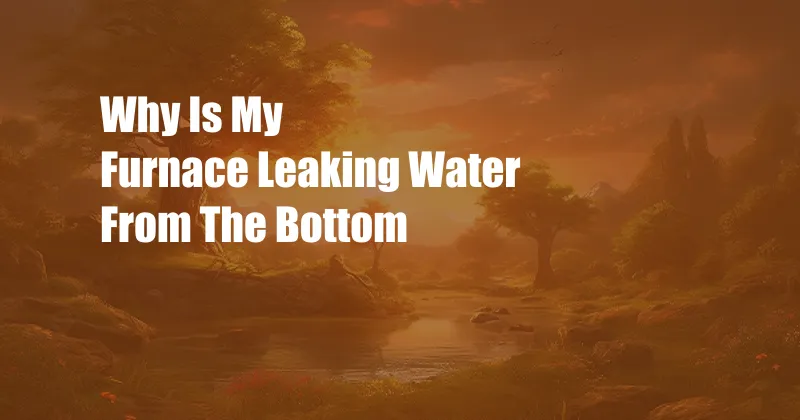
<!DOCTYPE html>
Why is My Furnace Leaking Water from the Bottom?Why is My Furnace Leaking Water from the Bottom?
I was in the middle of a cozy winter evening when I noticed something was amiss. My furnace, usually a quiet and reliable companion, was making strange gurgling and dripping sounds. As I approached it, I noticed a small puddle of water had formed underneath it. Panic set in as I realized my furnace was leaking water from the bottom.
I frantically searched for answers and found myself overwhelmed by the myriad reasons why this could be happening. From blocked drains to cracked heat exchangers, there seemed to be a laundry list of potential culprits. Determined to find the source of the leak and fix it before any major damage occurred, I embarked on a journey of troubleshooting.
The Mysterious Furnace Leak
The water leak from the bottom of a furnace is not a scenario anyone wants to deal with, yet it’s not uncommon. This issue can arise due to multiple reasons, ranging from condensation to more severe internal problems. Identifying the root cause of the leak is crucial for finding the appropriate solution and preventing further damage to your furnace and home.
To diagnose the leak effectively, begin by checking the condensate drain line. This line is responsible for draining the condensation produced during the combustion process, and a clog or blockage can cause water to accumulate and leak out. If the drain line appears clear, you might need to inspect the heat exchanger, a vital component that transfers heat from the combustion chamber to the air passing through the furnace. A cracked or damaged heat exchanger can result in water and combustion gases leaking into the furnace’s cabinet, leading to a leak from the bottom.
Other possible causes of a furnace leak include a faulty drain pan, a malfunctioning humidifier, or a clogged air filter. As these components play significant roles in the furnace’s operation, any issues with them can disrupt the system’s functionality and result in water leakage.
Importance of Prompt Action
It’s imperative to address a furnace leak promptly, as it can lead to various problems if left unattended. Not only can the water damage the furnace itself, but it can also create a breeding ground for mold and mildew, posing health risks for your family. Furthermore, a furnace leak can escalate into more severe issues, such as electrical hazards or carbon monoxide poisoning. Therefore, addressing any water leakage from your furnace should be a top priority to prevent further complications.
Troubleshooting Tips from Experts
If you’re facing a furnace leak, don’t panic. Before calling a professional HVAC technician, try these troubleshooting tips to identify and potentially resolve the issue yourself:
- Check the condensate drain line: Make sure the condensate drain line is not clogged by debris or ice. Clear any blockage by pouring a cup of hot water with a little bit of bleach down the drain line.
- Inspect the heat exchanger: If the condensate drain line is clear, check the heat exchanger for any cracks or damage. This is a more serious issue and will require professional repair.
If you’re uncomfortable performing these checks yourself, or if the leak persists, it’s advisable to contact a qualified HVAC technician for proper diagnosis and repair. They possess the necessary expertise and tools to pinpoint the exact cause of the leak and provide a reliable solution.
General FAQ on Furnace Leaks
To further assist you in understanding furnace leaks, here’s a list of commonly asked questions and concise answers:
- Q: What are the most common causes of a furnace leaking water from the bottom?
- A: Blocked condensate drain line, cracked heat exchanger, faulty drain pan, malfunctioning humidifier, or clogged air filter.
- Q: Can I fix a furnace leak on my own?
- A: While it’s possible to address minor issues like clearing a clogged condensate drain line, it’s generally recommended to contact a professional HVAC technician for accurate diagnosis and repair.
- Q: Is it safe to operate a furnace that is leaking water?
- A: No, operating a leaking furnace can lead to further damage and potential safety hazards. Shut off the furnace and contact a qualified technician immediately.
Seek Professional Help When Needed
As mentioned earlier, it is important to know when to call in a professional HVAC technician. While some minor furnace leaks can be resolved with DIY troubleshooting, more complex issues require the expertise of a qualified technician. They have the knowledge and experience to correctly diagnose the problem and recommend the best course of action, ensuring a safe and efficient repair.
Conclusion: Watertight Solution
A furnace leak from the bottom is a common problem with various potential causes. By understanding the possible culprits and following the troubleshooting tips provided, you may be able to identify and address the issue yourself. However, if the leak persists or you’re unsure about the cause, don’t hesitate to contact a professional HVAC technician. Their expertise will ensure a proper diagnosis and repair, restoring your furnace to optimal operation and giving you peace of mind knowing your home is safe and comfortable.
So, if you find yourself puzzled by a mysterious furnace leak from the bottom, don’t let it dampen your spirits. Take the necessary steps to identify the source of the leak and resolve it promptly. Remember, a well-maintained furnace not only provides warmth and comfort but also safeguards your family’s well-being.
Are you experiencing a furnace leak from the bottom? Share your troubleshooting journey or ask any questions you may have in the comments below. Together, let’s keep our furnaces running smoothly and our homes cozy!